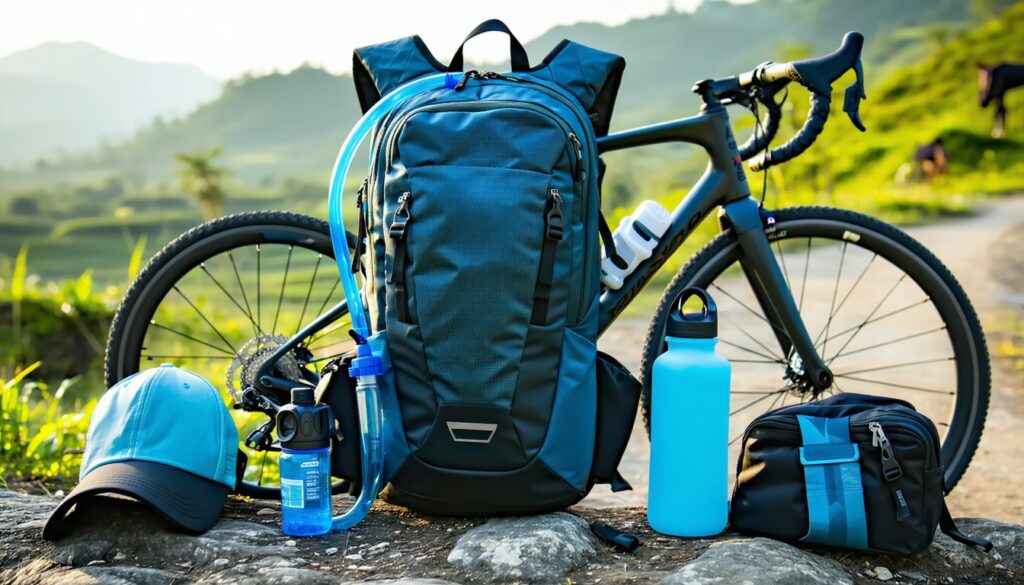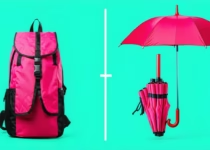Hydration-Compatible Cycling Backpacks: What to Look For

Key Features to Consider
When choosing the right hydration-compatible cycling backpack, there are specific features that cyclists should keep in mind to ensure they have an optimal riding experience. These include water and gear capacity, strap and harness design, and bite valve and hose features.
Water and Gear Capacity
The capacity of hydration packs is a crucial factor for cyclists. Depending on the length and intensity of the ride, cyclists may need different water supply levels. Hydration packs are available in various reservoir capacities, ranging from 0.5 liters (16 fluid ounces) for short, lightweight pursuits to over 3 liters (100 fluid ounces) for longer adventures. Many cyclists prefer larger reservoirs to minimize the number of refills during prolonged rides (REI).
| Reservoir Capacity | Ideal Use |
|---|---|
| 0.5 L (16 oz) | Short rides such as running or casual cycling |
| 1.5 L (50 oz) | Moderate rides with fewer stops |
| 3 L (100 oz) or more | Extended rides or long bike tours |
Strap and Harness Design
Comfort is integral when riding, especially for long durations. A well-designed strap and harness system stabilizes the backpack while in motion. Look for packs with adjustable straps, sternum straps, and waist straps that distribute weight evenly. This feature not only enhances comfort but also helps in improving posture and stability on the bike. Straps that are padded and breathable will also reduce pressure points and prevent discomfort during rides. For more information on strap comfort, check out our article on how to choose an ergonomic cycling backpack for comfort and posture.
Bite Valve and Hose Features
The bite valve and hose mechanism are crucial for an efficient hydration experience. Many hydration packs offer advanced features, including bite valve shutoff switches that prevent leaks, clips for easy tube access, and quick-disconnect tubing for fast refills. Cyclists should also look for wide-mouth openings on reservoirs for easy cleaning and maintenance. Some models even come with cold-weather additions for insulation. For complete performance, users can explore the variety of features these packs can provide, ensuring they stay hydrated without hassle.
Choosing the right hydration-compatible cycling backpacks: what to look for involves a balance of water capacity, design comfort, and functional tubing features. Evaluating these elements will help cyclists select a backpack best suited to their riding style and needs.
Top Cycling Backpacks
When choosing a cycling backpack, it’s important to consider various options that best meet the hydration and storage needs of cyclists. Here are three top contenders in the category of hydration-compatible cycling backpacks.
CamelBak Chase Bike Vest
The CamelBak Chase Bike Vest is designed for comfort and functionality, making it a favorite for cyclists. Key features include:
- Reservoir Capacity: 1.5 liters
- Storage Capacity: 4 liters
- Special Features: Broad shoulder straps, quick-reach pockets, and internal compartments suitable for various gear.
This vest provides a snug fit while ensuring riders have easy access to essential items. For more information on comfort features, consider exploring how to choose an ergonomic cycling backpack for comfort and posture.
| Feature | Description |
|---|---|
| Reservoir Capacity | 1.5 liters |
| Storage Capacity | 4 liters |
| Weight | Lightweight |
| Ideal For | Short to medium rides |
CamelBak H.A.W.G. Pro 20
The CamelBak H.A.W.G. Pro 20 backpack has been praised for its large storage capacity and comfort. Key specifications include:
- Reservoir Capacity: 3 liters
- Storage Capacity: 20 liters
- Special Features: Exceptional airflow and adjustable straps for a better fit.
This model is particularly beneficial for long rides, offering a great balance between hydration and gear storage. To further understand why fit matters in cycling backpacks, check out how sternum and waist straps improve stability on the bike.
| Feature | Description |
|---|---|
| Reservoir Capacity | 3 liters |
| Storage Capacity | 20 liters |
| Weight | Medium to Heavy |
| Ideal For | Long-distance rides |
Source Summit 15L
The Source Summit 15L backpack stands out with its generous capacity and features aimed at long rides. It offers:
- Reservoir Capacity: 3 liters
- Storage Capacity: 15 liters
- Special Features: Mesh dividers for easy organization and insulated compartments to help keep water at a consistent temperature.
These features combined make it an excellent choice for maintaining hydration on longer cycling adventures. For more insights, look at best practices for organizing your gear in a bike backpack.
| Feature | Description |
|---|---|
| Reservoir Capacity | 3 liters |
| Storage Capacity | 15 liters |
| Weight | Lightweight |
| Ideal For | Long rides, bikepacking trips |
By considering these options, cyclists of all ages can find the right hydration-compatible cycling backpacks that suit their needs. Each backpack has unique features that cater to various preferences and riding styles, ensuring hydration and comfort on the go.
Factors for Choosing the Right Backpack
Selecting a hydration-compatible cycling backpack requires careful consideration of several key factors. The right backpack can enhance the cycling experience by ensuring comfort, functionality, and durability while addressing specific cycling needs.
Comfort and Fit
Comfort is paramount when choosing a cycling backpack. Riders should look for backpacks with padded and ventilated shoulder straps, which help distribute weight evenly and reduce pressure points during long rides. Backpacks with a good fit minimize movement and instability while cycling. The use of hip belts and sternum straps can further improve stability and prevent the backpack from bouncing during rides. It’s advisable to explore how to choose an ergonomic cycling backpack for comfort and posture for more tips.
Storage Organization
Adequate storage organization is crucial for any cyclist. A well-organized backpack should have designated compartments for hydration reservoirs, tools, snacks, and clothing. Features such as fleece-lined pockets for valuables and specialized compartments for gear can enhance functionality. When packing, it’s essential to know how to pack tools, snacks, and gear in a bike backpack to ensure easy access to essentials while riding.
| Storage Feature | Description |
|---|---|
| Hydration Reservoir Compartment | Holds water bladder safely and provides easy access to drinking tube. |
| Tool and Repair Kit Pocket | Keeps tools organized and accessible for quick repairs. |
| Fleece-lined Valuables Pocket | Protects electronics and sensitive items from damage. |
Insulation and Temperature Control
For cyclists taking long rides, insulation and temperature control can be important. Some hydration packs come with insulation to keep drinks cool, especially on hot days. If a cyclist often rides in various weather conditions, a backpack featuring rain covers is a beneficial addition. When choosing the ideal features, consider waterproof vs water-resistant: choosing bike-safe backpacks for added protection.
Maintenance for Durability
Maintaining the longevity of a backpack is essential, especially for avid cyclists. Features such as durable materials, reinforced stitching, and easy-to-clean components can add to the durability of the bag. Riders should consider how to clean a cycling backpack after rainy rides to prevent mold and damage caused by moisture. Regular maintenance will ensure the backpack remains in good condition through various journeys. Always inspect zippers and straps for performance and wear to ensure maximum lifespan.
These factors help cyclists find a hydration-compatible backpack that meets their needs while ensuring comfort, functionality, and longevity on every ride. By understanding what to look for in a cycling backpack, cyclists of all ages can enhance their biking experiences.


